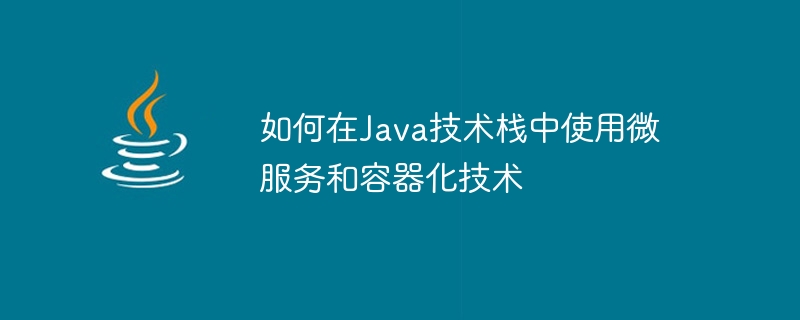

How to use microservices and containerization technology in the Java technology stack
With the rise of cloud computing and big data, traditional single applications can no longer meet the needs of rapid development development needs. The emergence of microservices and containerization technology provides a more flexible and scalable way for software development and deployment. This article will introduce how to use microservices and containerization technology in the Java technology stack and provide corresponding code examples.
1. Overview of Microservice Architecture
Microservice architecture is an architectural style that splits complex applications into small and autonomous services. Each service can be developed, deployed, and scaled independently, communicating with each other through lightweight communication protocols. Compared with traditional monolithic applications, microservice architecture is more elastic and scalable, and can achieve a high degree of parallel development.
2. Introduction to Java Microservice Framework
In the Java technology stack, there are many microservice frameworks to choose from, such as Spring Cloud, Micronaut, Quarkus, etc. This article takes Spring Cloud as an example to introduce how to use this framework to build microservice applications.
mvn spring-boot:run
<dependency>
<groupId>org.springframework.cloud</groupId>
<artifactId>spring-cloud-starter-netflix-eureka-server</artifactId>
</dependency>
<dependency>
<groupId>org.springframework.cloud</groupId>
<artifactId>spring-cloud-starter-config</artifactId>
</dependency>@EnableEurekaServer annotation to the main class of the application to enable Eureka Server: @SpringBootApplication
@EnableEurekaServer
public class EurekaServerApplication {
public static void main(String[] args) {
SpringApplication.run(EurekaServerApplication.class, args);
}
}@RestController
public class HelloController {
@GetMapping("/hello")
public String hello() {
return "Hello, World!";
}
}@EnableEurekaClient annotation to enable Eureka Client. @SpringBootApplication
@EnableEurekaClient
public class HelloServiceApplication {
public static void main(String[] args) {
SpringApplication.run(HelloServiceApplication.class, args);
}
}eureka:
client:
service-url:
defaultZone: http://localhost:8761/eureka/http://localhost:8761. You can see that Hello Service has been registered on Eureka Server. Then, accessing http://localhost:8080/hello will return "Hello, World!". 3. Overview of Containerization Technology
Containerization technology is a technology that packages applications and their dependencies into portable images to achieve application isolation and deployment consistency. Docker is one of the most popular containerization technologies currently. This article will use Docker as an example to introduce how to containerize microservice applications.
FROM openjdk:8 COPY target/myapp.jar /app/myapp.jar CMD ["java", "-jar", "/app/myapp.jar"]
Among them, openjdk:8 is the base image, and the COPY command is used to copy the application jar package to the image. , the CMD command specifies the command to be executed when the container starts. Then, use the following command to build the image:
docker build -t myapp .
docker run -p 8080:8080 myapp
Where, -pThe parameter specifies the mapping of the internal port of the container to the port of the host.
The above is a basic introduction and sample code for using microservices and containerization technology in the Java technology stack. Microservices and containerization technology are important trends in current software development and deployment. I hope this article can be helpful to readers.
The above is the detailed content of How to use microservices and containerization technology in the Java technology stack. For more information, please follow other related articles on the PHP Chinese website!
